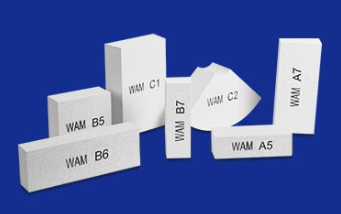The Best Solution For Energy Saving And Reducing CO2 Emission
The Best Solution For Energy Saving And Reducing CO2 Emission
 Tel: +86-532-85717690/85717352/85832089
Tel: +86-532-85717690/85717352/85832089 E-mail: wam@wamcn.net
E-mail: wam@wamcn.net
There are different standard shapes and sizes of refractory brick or insulating fire bricks depending on the applications.
Rectangular arrangements (standard square/straight) are generally considered normal and are used for straight walls and floors. Standard sizes are 9 x 4.5 x 2.5 inches and 9 x 4.5 x 3 inches, with the thicknesses of the parts.
There is also a progression of standard curved bricks that include various sides and curves, corners, wrenches, side and end slopes, columns, and side and end pieces.
These standard shapes are used for curves and rounded wall shapes and can be viewed by PC to precisely fit any space and curved doorways.
In the United States, straits are readily available in 23 to 32 stock 2.5- and 3-inch-thick packages from a few vendors, loaded and transported in beds
For most shapes, calculated and curved, these insulating refractory bricks are seldom loaded, but rather cut and custom cut by a few suppliers with fast turnaround times.
There are still a large number of heavily processed IFB furnaces, heaters, smelters, and stoves that need to be rebuilt and refurbished due to wear, wear and abuse.
Recently, the manufacture of new IFB furnaces has been limited to smaller specialized furnaces with clay fiber protection replacing some of the IFB applications in larger heaters.
There are different standard forms of refractory brick insulation depending on the application:
Rectangular layouts (standard/straight squares) are called NF or N designs and are used for straight walls. There are also configurations of bonds (B), double straights (D), and brackets/ stretchers (L) for fixing the straight masonry joint:
Side Curves (H), Keys (Q), End Curves (G), Double Curves (GG), and End Curve Bonds (GB) are used for the curves and shapes of round walls. The range for joints is specified as 2 mm.

Bonding designs are used for various purposes in construction. For example, the links recorded below are in many cases located on the facades of buildings.
· Regular Bond
progresses in the cradle cycle, as in the bond cycle (see above), but with a vertical cycle every fifth, sixth or seventh cycle.
· English Leap
Alternating headboard and course poles. This results in a thick, solid wall, despite it being just a thick brick.
· Flemish Leap
Cribs and alternate heads in each column. This pick gives a slightly more balanced look than the English link, but is a little less harsh, despite being thick.
Stack Bond
All courses are beds, similar to a running bond, but each brick is placed directly over the one below, with the joints aligned.
It gives a more elegant look, but has a minimum basic value and is most commonly used as a facade on load-bearing walls.
· Cot Bond
A bond that consists only of a household (sometimes used in reverse of a "running bond"). It reduces material wastage because bricks do not need slices for grading.
These are not the main connections, and other brick connections can be used in conditions that do not need bearing capabilities, for example, cleaning facades and streets.
Since the main part of the load-bearing is not included, the links can be more creative.
Insulating fire bricks have a long-standing reputation of being one of the best types of bricks for different construction purposes.
However, sourcing for them from a reliable and highly professional manufacturer will guarantee that you invest in the best products.
So, in case you need to buy premium insulating fire brick, you can contact us for a smooth deal.